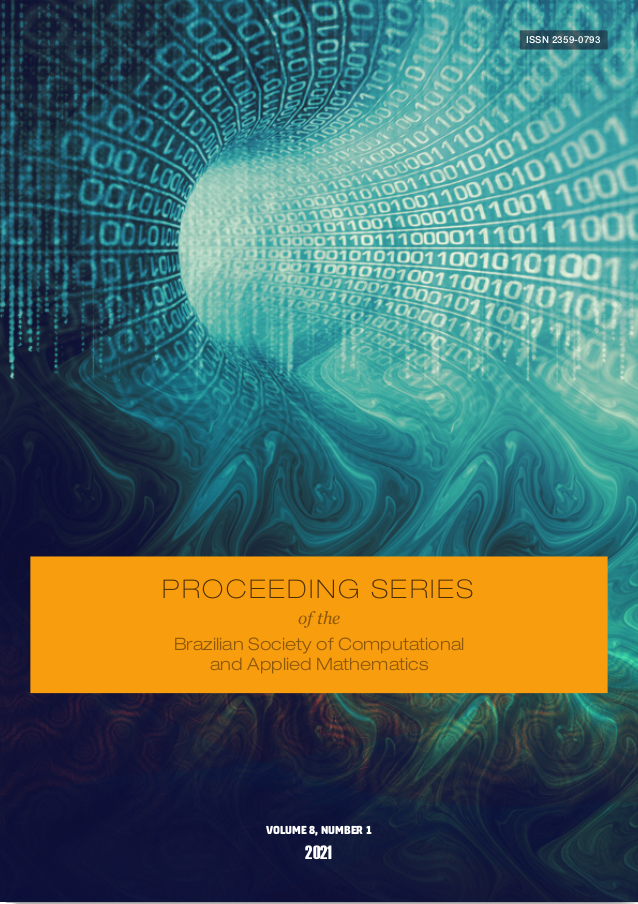Modelagem matemática aplicada à dinâmica de células imunológicas mediante a presença de populações tumorais
DOI:
https://doi.org/10.5540/03.2021.008.01.0436Palabras clave:
Câncer, imunologia, modelagem matemáticaResumen
O câncer é uma patologia que tem como característica a mutação de células
saudáveis em células anormais (tumorais), desenvolvendo-se de forma desordenada e agressiva. Na presente investigação, apresenta-se um modelo matemático que descreve a interação do sistema imunológico com as células tumorais. O modelo inclui a atuação e ativação de células da imunidade inata, como macrófagos dos tipos I e II, e da imunidade adaptativa, tais quais linfócitos T e B, bem como aborda a produção e secreção de citocinas pró e anti-inflamatórias por tais células. Para tal, fez-se uso de um modelo matemático proposto em [1] e novas equações referentes ao crescimento populacional celular de eosinófilos, basófilos e mastócitos, buscando enriquecer a representação do fenômeno biológico em questão.
Descargas
Citas
Amima, I. M. Investigating tumour micro environment dynamics based on cytokine-mediatedinnate-adaptive immunity, Disserta ̧c ̃ao de Mestrado, Stellenbosch University, 2018.[2] Bellomo, N. and Preziosi, L. Modelling and mathematical problems related to tumor evolutionand its interaction with the immune system,Mathematical and Computer Modelling, 32:413-452, 2000. DOI: 10.1016/S0895-7177(00)00143-6.
Benzekry, S., Lamont, C. et al. Classical mathematical models for description and predic-tion of experimental tumor growth,PLoS Computational Biology, 10:e1003800, 2014. DOI:10.1371/journal.pcbi.1003800.
Breems, N. Y. den and Eftimie, R. The re-polarisation of M2 and M1 macrophagesand its role on cancer outcomes,Journal of Theoretical Biology, 390:23–39, 2016. DOI:10.1016/j.jtbi.2015.10.034.
Byrne, A. , Savas, P., et al. Tissue-resident memory T cells in breast cancer control andimmunotherapy responses,Nature R. Clinical Oncology, 2020. DOI: 10.1038/s41571-020-0333-y.
Diefenbach, A. , Jensen, E. R., Jamieson, A. M. and Raulet, D. H. Rae1 and H60 li-gands of the NKG2d receptor stimulate tumour immunity,Nature, 413:165-171, 2001. DOI:10.1038/35093109.
Eftimie, R. and Hamam, H. Modelling and investigation of the CD4+ T cells–macrophagesparadox in melanoma immunotherapies,Journal of Theoretical Biology, 420:82-104, 2017.DOI: 10.1016/j.jtbi.2017.02.022.
Gupta, S., Harper, A., Ruan, Y., Barr, R., Frazier, A. L., Ferlay, J, Steliarova-Foucher, E. andFidler-Benaoudia, M .M. International trends in the incidence of cancer among adolescentsand young adults,J. of the National Cancer Institute, 2020. DOI: 10.1093/jnci/djaa007.
Keohane, E. M., Rodak, B. F., Smith, L. J. and Walenga, J. M.Rodak’s Hematology: clinicalprinciples and applications, 5a. edi ̧c ̃ao. Elsevier Saunders, 2016.[10] Kindt, T. J., Goldsby, R. A., et al.Kuby Immunology, 6a. edi ̧c ̃ao. W. H. Freeman, 2007.
Kirschner, D. and Panetta, J. C. Modeling immunotherapy of the tumor–immune interaction,Journal of Mathematical Biology, 37:235-252, 1998. DOI: 10.1007/s002850050127.
Kuznetsov, V. A., Makalkin, I. A., Taylor, M. A and Perelson, A. S. Nonlinear dynamicsof immunogenic tumors: parameter estimation and global bifurcation analysis,Bulletin ofMathematical Biology, 56: 295-321, 1994. DOI: 10.1016/S0092-8240(05)80260-5.
Lippitz, B. E. Cytokine patterns in patients with cancer: a systematic review,The LancetOncology, 14:e218–e228, 2013. DOI: 10.1016/S1470-2045(12)70582-X.
Liu, E., Marin, D., et al. Use of CAR-Transduced Natural Killer Cells in CD19-PositiveLymphoid Tumors,The New England Journal of Medicine, 382:545-553, 2020. DOI:10.1056/NEJMoa1910607.
Mumm, J. and Oft, M. Cytokine-based transformation of immune surveillance into tumor-promoting inflammation,Oncogene, 27:5913–5919, 2008. DOI: 10.1038/onc.2008.275.
Murphy, K.Imunobiologia de Janeway, 8a. edi ̧c ̃ao. Tradu ̧c ̃ao: D. C. Machado, G. Renard, L.P. Gualdi; revis ̃ao t ́ecnica: D. C. Machado. Artmed, Porto Alegre, 2014.
Park, Y. M. and Bochner, B. S. Eosinophil Survival and Apoptosis in Health and Disease,Allergy Asthma Immunology Research, 2:87-101, 2010. DOI: 10.4168/aair.2010.2.2.87.
Pillis, L. G., Radunskaya,A. E. and Wiseman, C. L. A validated mathematical model ofcell-mediated immune response to tumor growth,Cancer Research, 65:7950-7958, 2005. DOI:10.1158/0008-5472.CAN-05-0564.
Sompayrac, L. M.How the immune system works. John Wiley & Sons, Iowa, 2015.
Uhr, J. W., Tucker, T., et al. Cancer dormancy: studies of the murine BCL1 lymphoma,Cancer Research, 51:5045s–5053s, 1991.
Weller, P. F. and Lim, K. Human eosinophil-lymphocyte interactions,Mem. Inst. OswaldoCruz, 92:173-182, 1997. DOI: 10.1590/S0074-02761997000800023.
Wilkie, K. P. and Hahnfeldt, P. Tumor-immune dynamics regulated in the microenvironmentinform the transient nature of immune-induced tumor dormancy,Cancer Research, 73:3534-3544, 2013. DOI: 10.1158/0008-5472.CAN-12-4590.

